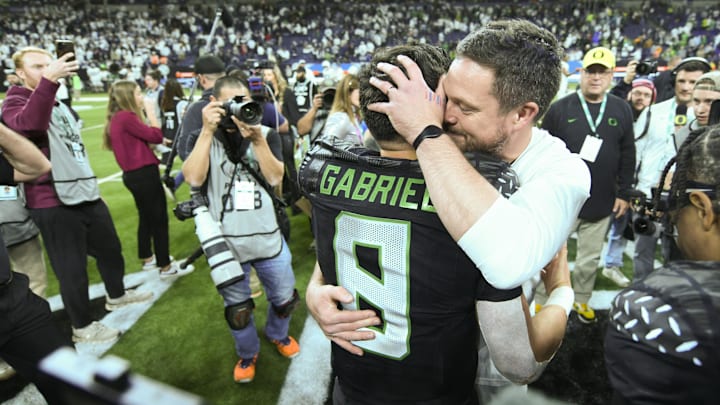They are the best in their profession. At least this season. The 12 coaches in the College Football Playoff soon will begin their quest for a national championship. The march will test their ability, composure, resolve and other skills that took root during their earliest days in the sport, which brings up an interesting question: […]

They are the best in their profession. At least this season.
The 12 coaches in the College Football Playoff soon will begin their quest for a national championship. The march will test their ability, composure, resolve and other skills that took root during their earliest days in the sport, which brings up an interesting question: Which of the Playoff 12 was the best player?
Advertisement
It’s a unique group. Not one played a regular-season contest in the NFL. One didn’t even play in college. One rushed quarterbacks on the field and worked at a local steakhouse off it. One looked more like a plumber than a quarterback. One played for his dad until his dad got fired.
The youngest is 34, the oldest is 63. One was carried off the field after his last game. One was forced to medically retire. Another has an in-depth bio on his school’s website that doesn’t include one word about his playing days.
Before everything gets serious when the Playoff begins with Indiana at Notre Dame on Friday, let’s rank the coaches from their earliest days. As football players.
The Sun Devils were picked to finish last in this season’s Big 12, so slotting Dillingham here feels appropriate. At 34, he is the youngest head coach of the Playoff 12, a chihuahua nipping at the big dogs. Actually, Dillingham got a head start with this. Entering his high school senior season, he tore his ACL. A linebacker, Dillingham tried to play through it, but his coach delivered the hard truth: You have no size. You have no speed. This is your reality.
That’s why Dillingham is the only head coach on this list to not have played college football. While his peers were on the field, he was coaching high school ball and bugging Arizona State coaches about letting him hang around.
11. Spencer Danielson, Boise State
A linebacker, Danielson started his career at the University of San Diego before transferring to then-NAIA Azusa Pacific, where he played alongside his brother. In a 2018 interview with The Idaho Statesman, former Azusa Pacific coach Victor Santa Cruz recalled with amusement the time Danielson blasted a teammate during off-season 7-on-7 work. “All gas, no brakes,” Santa Cruz said of Danielson.
10. Dan Lanning, Oregon
Lanning’s intensity traces back to his days as a linebacker at William Jewell College, a Division II school in Missouri. Per The Oregonian, Lanning once was called out for loafing twice during a game. His solution: writing “loaf” on his taped-up wrists so he could remember to go all-out every play.
Advertisement
Unlike most students, Lanning bought a house in college. He also worked at Outback Steakhouse, where he met his future wife. Although he battled shoulder injuries, Lanning had a strong senior season, earning all-conference recognition with 57 tackles, including 10.5 for loss.
9. Curt Cignetti, Indiana
A finance major, Cignetti was a reserve quarterback at West Virginia, where he initially played under his dad, head coach Frank Cignetti. When the elder Cignetti was fired after four losing seasons in 1979, the younger Cignetti stayed with the Mountaineers. “I thought about leaving, but I had a good spring practice in 1980 and I thought, ‘Maybe I can play here,’’’ Cignetti said in 1983. “When you’re No. 2, you always have some hope. But even when I didn’t play, I stayed around and I think I earned their respect.”
 GO DEEPERIndiana’s Curt Cignetti has ignited a fire: ‘This guy is just different’
GO DEEPERIndiana’s Curt Cignetti has ignited a fire: ‘This guy is just different’
8. Rhett Lashlee, SMU
Lashlee’s bio on the SMU website includes one sentence about his college days at Arkansas. And it does not mention football. Not a great development for this assignment. Deeper research revealed Lashlee walked on at Arkansas and was a backup quarterback until a shoulder injury forced him to medically retire in 2004. Then-coach Houston Nutt called Lashlee a dedicated solider. “He’s what you want your son to grow to be,” he told reporters. “Just a class, class individual who paid a tremendous price.”
7. Dabo Swinney, Clemson
Swinney is difficult to slot. In three seasons at Alabama, he didn’t do a ton, contributing on special teams and catching seven passes. He did, however, earn a scholarship after joining Gene Stallings’ program as a walk-on. He also won a national championship.
So what kind of player was he? “He was just an average player, but he wanted to be a good player,” Stallings said in a 2018 interview posted on Clemson’s website. Sometimes that’s all you need.
Advertisement
Former East Stroudsburg coach Dennis Douds once told a Pennsylvania television station that Franklin was among the greatest scrambling quarterbacks in the history of the Pennsylvania State Athletic Conference. This checks out. A highlight video found deep in the YouTube archives reveals a Division II quarterback who ran without fear.
Franklin tied or set 23 school records during his college days, including season marks in passing yardage (2,586), total offense (3,128) and touchdowns passes (19). In 2016, he was inducted into the school’s athletics Hall of Fame.
 GO DEEPERFor Denny Douds, football stays fun through watching pupils like James Franklin
GO DEEPERFor Denny Douds, football stays fun through watching pupils like James Franklin
The 6-foot-2 Day excelled as a dual-threat quarterback at New Hampshire, where he thrived under coordinator Chip Kelly and set nine school records. A sign of his intensity: Late in a lop-sided loss to Maine one year, Day got fed up with the Black Bears’ constant blitzing. To make his feelings known, he took a snap and fired a pass just above the head of Maine’s defensive coordinator.
“Yeah, that might have happened,” Day told The Athletic in 2020.
 GO DEEPERChip Kelly, Ryan Day and the early days of an American football revolution
GO DEEPERChip Kelly, Ryan Day and the early days of an American football revolution
A three-year starter at weak-side linebacker, Freeman was a key defensive piece for an Ohio State team that won four Big Ten titles and twice played in the national championship game. The Buckeyes went 51-12 with Freeman, a second-team All-Big Ten selection in 2007 and 2008 who finished his career with 264 tackles.
The Chicago Bears selected Freeman in the fifth round of the 2009 NFL Draft, and Freeman later spent time with the Bills and Texans, but he never played.

Kirby Smart had 13 interceptions as a Georgia safety. (Andy Lyons / Allsport)
3. Kirby Smart, Georgia
Like Arizona State’s Dillingham, Smart coaches his alma mater. Unlike Dillingham, Smart was a four-year letterman and an All-SEC safety. A play that reflected Smart’s ability: In the fourth quarter of a close win at Kentucky, Smart noticed Kentucky quarterback Tim Couch changing the play. Seconds later, Couch threw a short pass to the left, and there Smart was, positioned to pick it off. “He stole the signal and started moving even before we snapped the ball,” Kentucky tackle Kris Comstock told reporters.
Advertisement
Added Couch: “He’s a very intelligent football player, and he just made a smart play.”
2. Steve Sarkisian, Texas
After watching Sarkisian lead BYU over Kansas State in the 1997 Cotton Bowl, a Dallas sports columnist wrote the following: “Compared to the physical outlines of the classic quarterback, the guy looks like a plumber. … He has the short legs of a linebacker, the overall build of an undersized guard and runs slower than he looks.” But over two BYU seasons after transferring from junior college, Sarkisian proved he knew how to play the position.
As a senior, he threw for 4,027 yards, earning WAC Offensive Player of the Year and second-team All-America honors. Sarkisian then played three seasons in the CFL.
1. Josh Heupel, Tennessee
Heupel had a storybook career after starting his career at Weber State and Snow College, where he was recruited to Oklahoma by offensive coordinator Mike Leach under new coach Bob Stoops in 1999. In 2000, Heupel led Oklahoma to a 13-0 record and the national championship. After a 13-2 win over Florida State in the Orange Bowl, teammates carried the quarterback off the field.
“He’s been a student of the game since he was 5, studying with his father, (who was also a coach,)” then-Oklahoma quarterbacks coach Chuck Long told reporters. “A lot of guys have physical talent, but what sets him apart is his intelligence and his accuracy.”
Heupel finished as the Heisman Trophy runner-up, losing to Florida State QB Chris Weinke by just 76 voting points and finishing ahead of Drew Brees and LaDainian Tomlinson. A few months later, the Miami Dolphins picked him in the sixth round of the 2001 draft, but injuries kept Heupel from making the team.
(Top photos of Steve Sarkisian and Josh Heupel: Stephen Dunn / Allsport, Andy Lyons / Getty Images)














